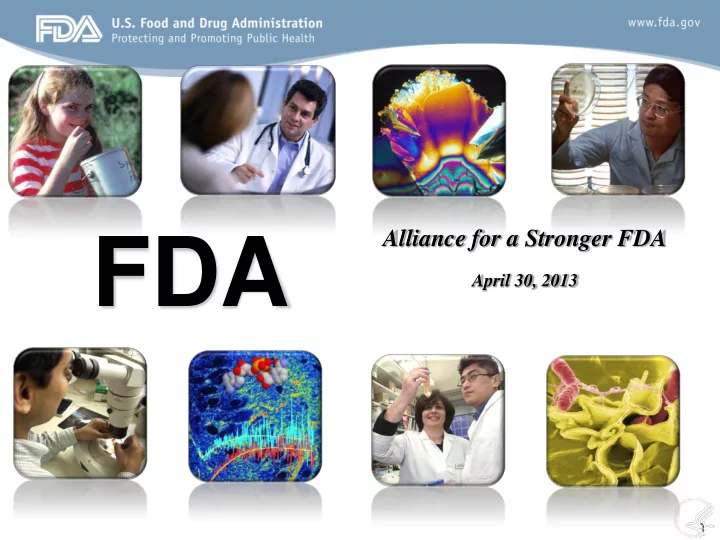

Alliance for a Stronger FDA FDA April 30, 2013 1
FDA Operational Strategies Walter Harris, FDA Deputy Commissioner for Operations and Chief Operating Officer 2
Deputy Commissioner for Operations and COO – Keep the FDA trains running – Provide an Operational Foundation that support science and aid in the protection of the public’s health 3
The Vision of the COO • Create a more Efficient, Collaborative and Energized operational environment: – “Corporate Structure” with controls – Autonomy and Innovation” • Human Resources: – Workforce Development – Hiring Processes and Procedures • Acquisitions Strategies and Options – – Flexible – Time Sensitive 4
The Vision of the COO • Transparency in Financial Planning and Execution – Increased in participation in budget from all programs at FDA – Increase in funding levels at FDA – Positive Economic Impact on the community • Complete the White Oak Consolidation – Lab science complete 2014 – Completion Building 25 & 45 – Center for Biologics Evaluation and Research 5
The Vision of the COO • Information Technology “Total Refresh” – Service and Delivery Model – Support to Scientific Computing – Leading Edge Innovation – Cohesive Relationships 6
IT Operational Goals Goal 1 Goal 2 Goal 3 Goal 4 Provide Develop a Create Fiscal Develop skills and Technology on Knowledge Opportunity: leadership pipeline : Demand: Architecture and • Efficient delivery of • Highly engaged, Infrastructure that: • Modernize internal high value services qualified and • Enables smooth infrastructure that reduce costs customer-centric • Provide external FDA operations, and create members reinvestment • Efficient review • Experts in capabilities that opportunities optimize the processes, technologies and productivity of the understand the • Risk-based FDA workforce business and analytics, scientific domains • Secure and that they serve seamless collaboration with public and private partners 7
FDA Budget Priorities at FDA James (Jay) Tyler, FDA Chief Financial Officer 8
FDA Budget Priorities FDA’s priorities continue to be: (1) modernizing the food safety system and improving the safety of imported food; (2) bringing safer, high quality and innovative medical products swiftly to the American people and strengthening protection of the global drug supply chain; (3) decreasing initiation of tobacco use among youth and encouraging cessation; and (4) advancing medical counter measures to protect our nation in the face of public health emergencies. 9
FDA’s FY 2013 Appropriation and Sequestration, cont’d • FDA received a net increase of about $4 million in its budget authority for the remainder of fiscal year 2013 under the Consolidated and Further Continuing Appropriations Act (CR) that was signed into law by President Obama on March 26. • This increase takes into account a 2.7% combined, across-the-board rescission enacted in the FY2013 bill. • For FDA’s user fee programs, the act includes the FY 2013 authorized levels for all current law user fees, including the new generic drugs and biosimilar fees. • Included in the appropriation for FDA is an additional $50 million in one time funds - $40 million to support implementation of the Food Safety and Modernization Act and $10 million for improving the safety of the human drug supply. 10
FDA’s FY 2013 Appropriation and Sequestration • Other specific increases in the act included $10 million for inspections in China, $12.5 million for food safety, and $3.5 million for medical countermeasures activities. • Current budget pressures pose yet additional challenges for FDA. FDA will lose about $209M ($124M in BA and $85M in user fees) as a result of the sequestration cuts. • FDA is dealing with these cuts via not hiring to the levels we need, cutting travel, training, conferences, research, consulting contracts, and grants. These will certainly impair our ability to issue regulations and guidance, keep up with our inspections work, and deliver on performance commitments with industry to speed the pathway to approval for many of the products the American people need to improve their quality of life. 11
FDA Fiscal Year (FY) 2014 President’s Budget FY 2014 Budget Highlights • The U.S. Food and Drug Administration is requesting a budget of $4.7 billion to protect and promote the public health as part of the President’s fiscal year (FY) 2014 budget. It is a 21 percent increase over the FDA enacted budget for FY 2012. Industry user fees would fund 94 percent of the proposed budget increase. The FY 2014 request covers the period from Oct. 1, 2013 through Sept 30, 2014. • The 2014 Budget Authority request allows FDA to increase the overall Food safety budget by $43.4M to $1.188B, improve Medical Product Innovation and FDASIA implementation through an increase of $19.9M in infrastructure investments, which includes $18M for outfitting the Life Sciences-Biodefense Complex (LSBC) on the White Oak Campus, to support biomedical research. 12
Continuing with FDA’s Budget Priorities • These are austere budget times, and the FDA budget reflects this reality. FDA’s budget increases are targeted to strategic areas that will help the agency fulfill its public health responsibilities and safeguard the American public. • FDA continues to be fiscally responsible in executing our budget authority. We carry out our broad public health responsibilities effectively and efficiently. Every American pays about $8 per year for the vast array of protections and services FDA provides, but almost certainly spends at least that much on FDA regulated products every day. 13
QUESTIONS 14
Recommend
More recommend